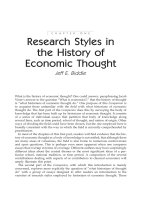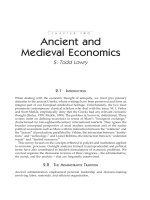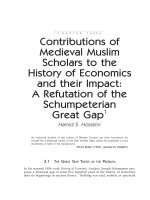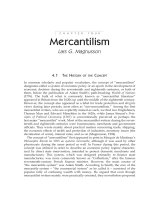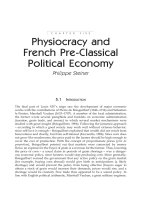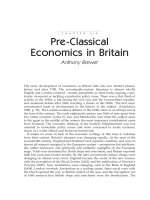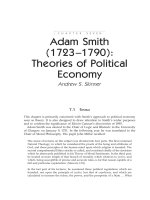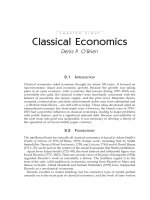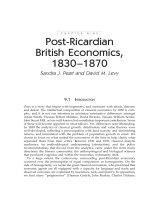A Companion to the History of Economic Thought - Chapter 6 docx
Bạn đang xem bản rút gọn của tài liệu. Xem và tải ngay bản đầy đủ của tài liệu tại đây (197.46 KB, 16 trang )
78 A. BREWER
CHAPTER SIX
Pre-Classical
Economics in Britain
Anthony Brewer
The early development of economics in Britain falls into two distinct phases,
before and after 1700. The seventeenth-century literature is almost wholly
English and London-centered – mainly pamphlets or short books arguing a par-
ticular viewpoint or tackling a particular policy issue. There was a first flush of
activity in the 1620s, a lull during the civil war and the Cromwellian republic,
and sustained debate after 1660, reaching a climax in the 1690s, “the first major
concentrated burst of development in the history of the subject” (Hutchison,
1988, p. 56). The London-centered debates of the 1690s came to an abrupt end at
the turn of the century. The early eighteenth century saw little of note apart from
two rather eccentric works by Law and Mandeville, and when the subject came
to life again in the middle of the century the most important contributions came
from Scotland. The economic thinking of the Scottish Enlightenment was less
oriented to immediate policy issues and more concerned to locate economic
issues in a wider ethical and historical framework.
It makes no sense to look at the economic writings of this time in isolation
from their context. Britain’s situation was changing rapidly. At the start of the
seventeenth century, England and Scotland were separate countries, and were in
almost all respects marginal to the European system – prosperous but intellectu-
ally rather backward, and politically and militarily negligible on the European
stage. Trade was dominated by Dutch ships and merchants, and Britain exported
little but wool and woolen textiles. By the later seventeenth century things were
changing on almost every front. England became the center of the new science,
with the foundation of the Royal Society (1662) and the publication of Newton’s
Principia (1687). New institutions were emerging, such as the Bank of England
(1694). London overtook Amsterdam as a trading center, three naval wars with
the Dutch opened the way to British control of the seas, and the Navigation Act
of 1660 ensured that British ships and merchants were the beneficiaries. The
PRE-CLASSICAL ECONOMICS IN BRITAIN 79
intense debates of the 1690s reflected the uncertainties of a period of change. By
the early eighteenth century the pattern was set, as Marlborough’s victories on
land made Britain, now united by the Act of Union of 1707, a major European
power. The main aims of British policy – to maintain control of the seas and to
prevent France dominating continental Europe – were set for a century or more
(Wilson, 1984; J. Brewer, 1989). As Daniel Defoe observed in 1724, England was
“the most flourishing and opulent country in the world.” The relative stability
and continuing growth of the eighteenth century allowed a more reflective (and
perhaps a more complacent) approach to economic issues.
6.1 SEVENTEENTH-CENTURY ENGLAND:
T
HE MAKING OF A GREAT POWER
6.1.1 Trade and the trade balance
To understand the voluminous literature on trade in seventeenth-century Eng-
land, one must first understand the way contemporary Englishmen saw their
situation relative to the Dutch. The United Provinces (the modern Netherlands)
had finally established their independence in 1648 after a ferocious 80-year war
against Spain. They were the trading and financial center of Northern Europe
and, in per capita terms, the richest place in Europe. English merchants obses-
sively scrutinized the Dutch to discover the secret of their success. Thus, Child’s
Brief Observations (1668) starts: “The prodigious increase of the Netherlanders
in their domestick and forreign Trade, Riches, and multitude of Shipping, is
the envy of the present and may be the wonder of all future Generations” but,
he continued, the Dutch could be imitated “by us of this Kingdom of England”
(1668, p. 3). If seventeenth-century writers thought that trade was the route to
wealth, it was because of the Dutch example. By the eighteenth century, England
had less cause to be envious and the debate subsided.
The seventeenth-century literature (or part of it) has often been labeled
“mercantilist” (see Magnusson, ch. 4, this volume), but the writers of the time
were too varied to be treated as a unified school of thought. There was indeed
widespread support for active policies of one sort or another to promote English
trade, usually at the expense of the Dutch and the French, but that is as far as it
goes.
Applying modern methods of analysis to seventeenth-century conditions, it is
not hard to make a case for “mercantilist” policies to promote Britain’s trade and
market share. The big profits were in trading with the Far East and the Americas,
using armed convoys and fortified settlements. Free trade in the modern sense
was not an option. More generally, there were economies of scale and scope in
entrepôt trade, and real opportunities to diversify England’s exports, with associ-
ated infant-industry arguments for protection. Seventeenth-century writers were
dimly aware of these issues, but lacked the analytic apparatus to discuss them in
terms acceptable to modern critics. Active policies were nonetheless adopted and
did in fact have the desired results.
80 A. BREWER
Many seventeenth-century debates focused on the balance of trade; that is, the
excess (or shortfall) of export revenue over import spending. The basic idea
can be traced back to the Middle Ages (Viner, 1937, p. 6). The metaphor of a
“balance” seems to have been introduced by Malynes in 1601, in the phrase
“overballancing” of trade. Much the most influential work on the subject was
Thomas Mun’s England’s Treasure by Forraign Trade, written in the 1620s but
published (in a quite different context) in 1664. The notion of an overall balance
of trade was undoubtedly an analytic advance. Mun contrasted the overall
balance tellingly with the balance on specific trades or the bilateral balance with
any particular country, and used it to distinguish between gains to merchants,
gains to the king, and gains to the nation as a whole. For a country that used
metallic money and had no domestic sources of precious metals, the balance of
trade really did determine the net inflow of specie and hence the change in the
money stock (neglecting nonmonetary uses of gold and silver, which could be
accounted for separately, and capital account transactions).
Unfortunately, it was fatally easy to confuse the balance of trade with the gains
from trade, and to treat it as an aim in itself. The simplest way to fall into this
trap would be to confuse wealth with money, or with precious metals. This is the
charge that Adam Smith brought against Mun and other writers of the seven-
teenth century, and it is hard to acquit them completely (Viner, 1937, pp. 15–22).
They did not think of precious metals as desirable in themselves, but they did, it
seems, find it difficult to distinguish between the stock of money and a stock of
wealth or capital. Thus, Mun argued that the “stock of a Kingdom” was like that
of a private man who becomes richer by spending less than he earns and adding
the difference to the “ready money in his chest” (1664, p. 5). In mitigation, one
might point out that it was important to have reserves of internationally accepted
metallic money in case of war, and that an inflow of money would stimulate the
domestic economy, but one would then have to meet the objection that an inflow
of money would raise the price level and make exports less competitive. Mun
was aware of this possibility, but seems to have seen it as no more than a minor
qualification, perhaps limiting the inflow of money rather than eliminating or
reversing it. Not everyone accepted the balance of trade as a relevant policy
aim and those who did could not agree on the policy conclusions. The issues
involved were not sorted out satisfactorily until Hume (1752; see below).
The “mercantilist” writers of the seventeenth century are often described as
opponents of free trade, but this is a misleading way to categorize them. Trade
had always been taxed and regulated, and there was no established notion of free
trade to act as a benchmark. What was new in the seventeenth century was not
the regulation of trade but the development of a vocabulary and a framework for
discussing the economic effects of regulation. In general, debates did not turn on
freedom of trade as a general alternative to regulation or protection, but on the
best policies to follow in particular cases. Thus Child (1693) recognized that
where trade was free the cheapest suppliers would prevail, but since the Dutch
were likely to be cheapest he saw that as an argument against free trade, while
Barbon (1690) was against the prohibition of imports to protect domestic sup-
pliers but in favor of using high duties to have the same effect. Early in the century,
PRE-CLASSICAL ECONOMICS IN BRITAIN 81
Misselden (1622) did indeed argue for free trade, but what he meant by it was the
opening of monopolistic companies such as the East India Company to other
(English) merchants. Where trade was “disordered” and “ungoverned,” however,
it should be brought to order.
It was from precisely these “mercantilist” debates that the concept of free
trade, in something like its modern sense, emerged at the end of the century; in,
for example, North (1691) and Martyn (1701). North led up to the conclusion that
“we may labour to hedge in the Cuckow, but in vain; for no People ever yet grew
rich by Policies; but it is Peace, Industry, and Freedom that brings Trade and
Wealth, and nothing else” (North, 1691, p. 28). North and Martyn, however, had
little impact at the time. Ironically, the main protective legislation, the Naviga-
tion Act, was progressively amended to make it more effective and was enforced
more rigorously thereafter, while tariffs were raised significantly to raise revenue
for military purposes. The case for free trade emerged just as trade was becoming
less free.
6.1.2 Money and the interest rate
Money was a perennial topic of discussion for a number of reasons. Money
consisted of coins at that time, and the English coinage was in a very poor state
because of wear and clipping. By the time of the eventual recoinage in 1696, coins
had on average fallen to half their supposed weight. Gresham’s Law (named
after Sir Thomas Gresham, advisor to Queen Elizabeth), that “bad money drives
out good” because it pays to pass on coins with a low metal content and melt
down better coins for the metal, was at work – the mint issued full weight coins,
but 99 percent vanished from circulation. Consideration of the amount of money
needed for circulation naturally led toward seeing the economy as a single whole,
while consideration of changes in the money stock connected it to the trade
balance and the relation between price levels in different countries. Fluctuations
in the relative value of gold and silver also posed problems.
The interest rate was also an issue. In medieval Europe, “usury,” or lending at
interest, had often been forbidden, at least in theory. By the seventeenth century,
financial markets were becoming quite well organized but the law still set a
maximum to interest rates. Repeated proposals to lower the maximum legal rate
to what would certainly have been an unsustainably low level came very close to
being passed in the 1690s. There were at least three views about interest rates: (a)
that they reflected the “plenty or scarcity” of money, providing a possible motive
for aiming at a positive trade balance to increase the money stock and allow
lower interest rates; (b) that they depended on supply and demand of loans, and
hence on net saving and on profit opportunities open to borrowers; and (c) the
naive view that they could be set by legal fiat.
From the 1660s on, Josiah Child (1630–99) argued for reducing the interest
rate by law, claiming that the rate had fallen as wealth increased, that it was lower
in rich than poor countries, and that the time was now ripe for it to fall again.
Low interest was the “causa causans” of prosperity because it would encourage
merchants and farmers to expand their businesses, and it would also encourage
82 A. BREWER
those with money to use it productively rather than simply letting it out at
interest. There are clearly the makings of the notion of a demand and a supply
function for investible funds here, but what is lacking is a clear notion of equilib-
rium between the two. Critics agreed that Holland had a low interest rate but
pointed out that this was achieved without legal compulsion. Child replied that
legislation might not be needed in Holland but it was in England, to allow
England to match Holland as a center of trade.
The opposing case, and much more, is to be found in some of the most import-
ant economic writings of the seventeenth century, by John Locke (1632–1704). As
early as 1668, he had prepared an unpublished draft on an earlier proposal to
reduce interest rates, but he was forced into exile until after the revolution of
1688, when his main philosophic works appeared in quick succession, followed
by a return to monetary issues in his Considerations (1691).
The basic idea of the quantity theory of money, that an increased quantity of
money will lead to a fall in its value and a rise in the prices of goods, had been
understood in general terms from early on. Locke argued it very clearly for an
isolated economy. Whatever the quantity of gold and silver, it “will be a steady
standing measure of the value of all other things” and can “drive any proportion
of trade” (Locke, 1691, pp. 75–6), since a smaller quantity will be valued more
highly. In modern terms, the nominal quantity of money is unimportant since
prices adjust to it. In an open economy, however, he argued that the value of
money was set at a world level. He thought that a country with a relatively small
money stock would be at a disadvantage, but hovered between arguing that its
prices would be low and its terms of trade unfavorable or that its trade would
be limited and resources unemployed. Either way, he supported the common
complaint that a shortage of money was a problem. Both Locke and his contem-
porary William Petty discussed the institutional determinants of the velocity of
circulation and hence the amount of money needed to drive a given amount of
trade. Both failed to grasp the specie-flow mechanism that Hume was later to
state so clearly.
Locke thought that setting a low legal maximum to the interest rate would be
ineffective in practice, and harmful if it were effective. In the absence of regula-
tion, interest rates are determined by demand and supply, explained in what, to
a modern reader, seem to be two different and conflicting ways. First, he claimed
that when money is scarce, its price (the interest rate) must rise, like any scarce
commodity. Interest is high when “Money is little in proportion to the Trade of a
Country” (Locke, 1691, pp. 10–11). Secondly, he explained interest rates in terms
of demand from borrowers who see profitable uses for capital and supply from
those who have more wealth than they can (or want to) employ themselves,
comparing it to rent, determined by the balance between potential tenants and
landowners with land to rent out (pp. 55–7). The explanation of this apparent
inconsistency between monetary and real theories of interest is that he seems to
have confused wealth or loanable funds with the stock of circulating money. “My
having more Money in my hand than I can . . . use in buying and selling, makes
me able to lend” (p. 55). If there were a “million of money” in England, but debts
of two millions were needed “to carry on the trade” – that is, if one million were
PRE-CLASSICAL ECONOMICS IN BRITAIN 83
available for lending, but borrowers needed to borrow two millions – the interest
rate must rise (p. 11). A low legal maximum would only make matters worse,
because it would reduce the amount people were willing to lend, leaving the
increased demand unsatisfied.
Dudley North (1641–91) presented an analysis (North, 1691) that has striking
similarities to Locke’s on some points, but which is diametrically opposed to him
on others. Interest rates, he argued, are determined by supply and demand for
loans. As in Locke, the supply comes from those who have more resources than
they want to employ themselves, and demand from those who see opportunities
but need to borrow to take advantage of them. Unlike Locke, however, North
saw that it was “stock” (capital or wealth) – not the quantity of money – that
determined the supply. Low interest rates, as in Holland, are the result, not the
cause, of wealth. Success in trade is the result of thrift and hard work, and leads
to the accumulation of wealth and hence to a large supply of loans.
North argued that shortage of money is never a problem, focusing not on
international movements of gold and silver but on movements of metal between
coins in circulation and hoards of bullion or plate. A shortage of coin will bring out
bullion and plate to be coined, while a surplus will be absorbed into hoards. He
was able to support the argument by pointing out that large amounts of silver had
been coined but that the new coins had disappeared to be melted down. The flow
of money accommodates itself, he claimed, without any help from politicians.
6.1.3 Political arithmetic and the state
Sir William Petty (1623–87) was trained as a doctor, became Professor of Anatomy
at Oxford and Professor of Music at Gresham College, and was one of the founder
members of the Royal Society. His key idea was to apply Baconian scientific
method, the use of “number, weight and measure,” to social and political issues.
This was “political arithmetic,” which aimed to provide impersonal, numerical
facts as a basis for policy.
His great early achievement, the mapping of Ireland, illustrates his attitude.
He had gone to Ireland as physician to Cromwell’s army, but he bid for and won
the contract to survey the country. His map was an outstanding scientific and
organizational achievement – perhaps the best map of any country at the time,
finished on time and within budget – but its purpose was to help with the
distribution of land to members of the victorious army. Petty himself emerged
with extensive lands in Ireland. He was fiercely ambitious, and attached himself
to whoever was in power, switching allegiance from Cromwell to Charles II
at the Restoration (as, of course, many others did). His policy proposals were
designed to strengthen the state, almost regardless of individual rights or inter-
ests. To make Ireland more secure and profitable for the British state, for example,
he advocated transferring most of the Irish to England, to be absorbed into
the much larger English population and eliminated as a separate people with a
different language and culture.
The most important of the state’s resources is its population, so population
estimates were the backbone of political arithmetic. The key work was the
84 A. BREWER
Observations on the Bills of Mortality (1662), by John Graunt (1620–74). Petty
certainly collaborated with Graunt and made similar calculations of his own,
but their exact roles are unclear. Records of deaths and christenings showed
that England as a whole produced a healthy surplus of births over deaths, but
that London could only maintain and increase its population by migration
from the rest of the country. Petty went on to use estimates of population and
assumed per capita income levels to make pioneering estimates of total national
income.
What use Petty made of these estimates, and the way they fit into the context
of his time, can best be seen in his Political Arithmetick of 1676 (published post-
humously in 1690; see Petty, 1899, pp. 233–313). He stated and supported ten
conclusions, including:
That a small Country, and few People, may . . . be equivalent in Wealth and Strength
to a far greater People and Territory. . . . That France cannot . . . be more powerful at
Sea than the English or Hollanders. . . . That the People and Territories of the King
of England are naturally near as considerable, for Wealth and Strength, as those
of France. . . . That one tenth part, of the whole Expence of the King of England’s
subjects; is sufficient to maintain one hundred thousand Foot, thirty thousand
Horse, and forty thousand Men at Sea, and to defray all other Charges, of the
Government. . . . That the King of England’s Subjects have Stock, competent, and
convenient to drive the Trade of the Whole Commercial World. (Petty, 1899,
pp. 247–8)
To see this in context, note that Parliament held the purse strings and would not
allow Charles II the funds to pursue an active policy. He accepted a subsidy from
Louis XIV, effectively making Britain a passive junior partner in French expan-
sionary plans. Petty’s calculations showed that England need not be anyone’s
junior partner. A small country it might be, but it could (and, under a new king,
did) aim to control the seas and to dominate the trade of the “commercial world”
(essentially the sea-borne trade of Europe). Petty estimated the requirements and
the costs with striking accuracy. In the wars around the turn of the eighteenth
century, Britain’s navy employed just about the 40,000 he proposed. The land
army was smaller than his 130,000, but Britain was effectively paying for its
allies’ troops as well. To do it, taxes had to rise from 3–4 percent of GNP to just
about the 10 percent that Petty proposed (Holmes, 1993, p. 439). Petty saw no
objection to allowing France to expand on the continent since England’s interests
lay at sea (Petty, 1927, vol. 1, p. 262), but later generations disagreed.
Petty’s writings contain a few digressions that have attracted (perhaps dispro-
portionate) attention. There is a suggestion of a labor theory of value (Petty, 1899,
vol. 1, pp. 43, 50–1, 90) and a (conflicting) suggestion that the value of a good
might be determined by the labor and land required to produce it, leading Petty
to speculate about a “par” or value-conversion factor between labor and land
(vol. 1, p. 181). This was later followed up by Cantillon, who referred to Petty’s
par as “fanciful” (Cantillon, 1755, p. 43). There are also passages that describe
some notion of a surplus of output over necessary subsistence (e.g., Petty, 1899,
vol. 1, pp. 30, 118). Petty did not follow up any of these in a systematic way and
PRE-CLASSICAL ECONOMICS IN BRITAIN 85
nor did anyone else, at least in Britain (there may be a line of descent via Cantillon
and Quesnay in France). To some who think that the labor theory of value and
the notion of surplus are particularly important, these digressions seem signi-
ficant. Seen in the context of the time, however, what is important in Petty
is, rather, his emphasis on quantification and on the role of different sectors
(agriculture, trade) in the economy as measured by their contribution to income
and to tax revenue.
Petty and Graunt had a number of successors. Edmund Halley (the astrono-
mer, 1656–1742) improved on Graunt’s population modeling using better data
(from Silesia). Gregory King (1648–1712) produced updated estimates of popu-
lation and national income, which were not published until later but were
drawn on by Charles Davenant (1656–1714) in the 1690s. “Political Arithmetic,”
as defined by Petty, did not survive long beyond the end of the seventeenth cen-
tury and was harshly criticized in the eighteenth century for excessive reliance
on unreliable data.
6.1.4 The seventeenth-century achievement
The seventeenth century inherited a medieval ideal of a static, hierarchical soci-
ety with well-defined functions, rights, and duties. Economic considerations came
second to the maintenance of a social order consecrated by custom and religion.
This was never more than an abstract ideal, but it shaped people’s thinking and
underlay legislation such as the Statute of Artificers of 1563, which regulated
entry and wages in different trades, backed up by the Poor Laws and by regula-
tion of foreign trade. Finkelstein (2000) has argued that much seventeenth-
century economic thought can be seen as an attempt to maintain the old order in
changing times.
At the same time, the debates of the seventeenth century produced, bit by bit,
a radically new idea, of “a natural order of economic relations impervious to
social engineering and political interference” (Appleby, 1978, p. 242). Interest
rates, for example, are governed by supply and demand, so attempts to fix them
by law are bound to fail or to damage the economy. Similarly, net flows of
monetary metals depend on the trade balance, and hence on a whole complex of
trading relations. Crude attempts to interfere may be counterproductive. The
idea of a national economy was emerging as a subject of discussion and as a
legitimate concern of government. Petty tried to estimate population and income
on a national level. The balance of trade is a genuinely national aggregate,
and Mun identified a national interest, distinct from the interest of individual
merchants or the king. Discussion of monetary issues led to a conception of a
national money stock, a nationwide circulation of money, and a national price
level distinct from the price level in other countries.
If the seventeenth century saw the emergence of the idea of an autonomous
sphere of economic relations, and hence, in a sense, the birth of economics as a
subject (not yet named or even recognized as such), this achievement was not
matched by any real attempt to trace the causal processes involved beyond a
rather superficial level. Thus, for example, Locke stated the basic idea of the
86 A. BREWER
quantity theory of money very clearly, but it was not until Hume, half a century
on, that the links between the quantity of money, the price level, and the balance
of payments were clarified. Many elements of later theories of capital accumula-
tion surfaced in the debates over interest rates without being brought together. It
was just at this point, when the makings of a real advance seem, in retrospect, so
obvious, that the advance of the 1690s fizzled out. Policy debates continued, of
course, but nothing really new or substantial emerged from them for many years.
What went wrong? Several key figures died before they could take the debate
further – Petty in 1687, North in 1691, Barbon in 1698, Child in 1699, and Locke in
1704 – but that does not explain why they left no successors. The key point may
be that the debates were driven by immediate policy problems. Once the main
issues of the 1690s were settled – the legal interest rate was not lowered after all,
the recoinage was carried out, and so on – there was no immediate stimulus to
take the argument further. Other, noneconomic, issues took center stage. There
were advances in the following period, but in France (Cantillon and others) or
Scotland (Hume and others).
6.2 TRANSITION: LAW AND MANDEVILLE
6.2.1 John Law
John Law (1671–1729) was an extraordinary character. A Scot by origin, he killed
a man in a duel in London in 1694 and had to flee for his life. For a while he was
safe in Scotland, then a separate country, but had to flee again on the Act of
Union in 1707. He wandered around Europe peddling proposals for monetary
reform and supporting himself as a professional gambler, before gaining the
confidence of the French regent. The results were dramatic. He founded a state-
backed bank in 1716 and then a joint-stock company, the Mississippi Company,
to take over French state debt in return for concessions in the overseas empire.
By manipulating monetary conditions, he engineered a spectacular speculative
boom in the shares of his company and was briefly able to replace the whole
French currency with notes issued by his bank. The bubble burst in 1720. Law
was ruined and the scandal rocked the French state. The collapse of Law’s “system”
left France, in particular, with a deep suspicion of monetary experiments.
His Money and Trade Considered (1705) was aimed at a Scottish audience, but
Law saw it as more widely applicable. He argued that Scotland was potentially
rich but its resources were underemployed. His answer was to expand the money
supply by issuing paper money. He is sometimes described as a proto-Keynesian,
but he seems to have seen a lack of supply, not demand, as the problem. Thus,
discussing price cuts to expand exports, he argued:
It may be alleg’d, we have more Product and Manufacture, than is consum’d or
exported; and selling cheaper, would occasion a greater demand for our Goods
Abroad. . . . Product and Manufacture might be much encreas’d, if we had Money to
imploy the People: But I’m of Opinion we have not any great Quantity of Goods,
more than what is consum’d or exported. (Law, 1705, p. 62)
PRE-CLASSICAL ECONOMICS IN BRITAIN 87
If output (the “yearly value” of the nation) were increased by £500,000, and if
a quarter of the increased income were spent on a greater consumption of home-
produced goods, a quarter on consumption of imports, and a quarter on building
up stocks of imported goods (“Magazines of Forreign Goods”), there would still
be an improvement in the balance of trade of a quarter of the increase in output
(Law, 1705, p. 146; see also pp. 16–18; Locke had a similar argument). The num-
bers were only illustrative, but the theoretical point is clear: increased demand is
the consequence, not the cause, of increased output. Increasing the money supply
would increase the supply of goods. Like others at the time, Law seems to have
thought of money and capital as interchangeable, so extra money would employ
more people and allow increased output.
For all its faults, Law’s theory raised real macroeconomic questions and sug-
gested ways of thinking about them, but after the collapse of his system his ideas
were discredited and had little impact.
6.2.2 Bernard Mandeville
Bernard Mandeville (1671–1733) was a doctor of Dutch origin, who had settled in
England. His verse satire, The Grumbling Hive, of 1705 was reissued repeatedly
as The Fable of the Bees: Or Private Vices, Public Benefits after 1714 with added
material by way of elaboration and defense of the original. The basic fable has
a thriving, growing, hive of bees, clearly representing England, which is per-
meated with “vice” at every level. A puritanical reformation brings luxury, crime,
and war to an end, but the result is mass unemployment (of bees!), falling popu-
lation, and decline.
Mandeville defined vice very broadly to make his satirical point, including
almost anything that the most extreme puritan could possibly object to – luxury
and extravagance as well as war and crime. His main line of argument is clearly
demand-orientated: ostentation creates a demand for fine clothes and other accou-
trements, burglars create a demand for locks and hence work for locksmiths,
and so on. Little needs to be said about this, beyond noting that he missed the
obvious point that if people did not need locks they might buy something else
instead. A second, implicit, argument is that the desire for luxury gives naturally
lazy men an incentive to work. These two lines of argument are logically distinct,
though they are often hard to separate in Mandeville’s text. Neither was wholly
new, but Mandeville stated them more forcefully than before.
Mandeville’s provocative style aroused general hostility but his arguments
bore fruit in the work of later writers, however unwilling they might be to admit
it. At the center is the idea of unintended consequences, which became a theme
of Scottish Enlightenment thought and of all subsequent economics – individual
motives and intentions may have no relation to the overall outcome. Specifically,
the actions of selfish individuals, driven by pride and avarice, may have socially
desirable results. Adam Smith’s invisible hand is clearly a less paradoxical devel-
opment of the same idea.
Mandeville typified the eighteenth-century approach in another way. The
seventeenth-century literature was driven by a conviction that England was not
88 A. BREWER
doing well enough and had to improve. Mandeville, like his successors, assumed
that England was doing well and getting even better. He sought to explain that
success and to argue against any basic change. Law, although he was an exact
contemporary, clearly belongs to the earlier tradition, perhaps because the one
place he could not settle was England.
6.3 THE EIGHTEENTH CENTURY AND THE SCOTTISH ENLIGHTENMENT
6.3.1 Population and economic growth
There was no population census in England before 1801, and few anywhere else.
Eighteenth- (and seventeenth-) century writers did not know what the popu-
lation was or whether it was increasing. Graunt and Petty had made a start,
but their estimates were open to criticism. Steuart, for example, rejected Petty’s
results because they clashed with his theory. There was even debate about whether
population had grown by comparison with classical antiquity. One of Hume’s
essays dealt with this question.
Population size and growth was widely used as an index of economic success,
since reliable estimates of income and output were even scarcer than estimates of
population, but there was no agreement on the direction of causality. The Graunt–
Petty estimates of population growth used estimates of births and deaths, which
Petty treated as essentially independent of economic success. Population growth,
he thought, would certainly increase total income, and perhaps income per head.
His notorious proposal to ship most of the Irish to England was based on the
assumption that an increase in the population of England would be a good thing.
Many seventeenth-century writers shared this opinion.
The alternative view, which was to dominate classical economics, saw popula-
tion as endogenous. Steuart, like Smith and Malthus a few years later, thought
that population presses against the limits set by subsistence, so that economic
success would automatically lead to population growth. On the other hand,
Josiah Tucker (1713–99), one of the few significant English economic writers of
the mid-eighteenth century, wanted to encourage immigration because he saw
an enlarged population as an asset. Whether population is seen as exogenous
or endogenous matters to the emergence of a concept of economic growth in
the late eighteenth century. Sustained economic growth was not taken for
granted then, as it has been in later centuries, and there was no agreement on
whether population and output had grown or would grow in the future (A.
Brewer, 1995).
6.3.2 David Hume
David Hume (1711–76) was a central figure in the “Scottish Enlightenment.”
With Francis Hutcheson (Adam Smith’s teacher and predecessor at Glasgow),
Adam Ferguson, and others, he pioneered an approach that was historical, in
that it saw human societies as the result of a long process of development, and
PRE-CLASSICAL ECONOMICS IN BRITAIN 89
rational, in that it refused to accept tradition or authority as a guide. His main
contributions to economics are to be found in a number of short but pointed
essays (1752).
His most influential contribution to economics was his magisterial treatment
of the interaction between money, prices, and the balance of trade. The basic
argument was simple. In a closed economy, the quantity of money is of no
importance, since prices adjust proportionately (as Locke had argued). In an open
economy, a change in the money supply causes a corresponding price change,
which in turn affects competitiveness:
Suppose four-fifths of all the money in Great Britain to be annihilated in one
night . . . Must not the price of all labour and commodities sink in proportion? . . .
What nation could then dispute with us in any foreign market? . . . In how little
time, therefore, must this bring back the money which we had lost, and raise us to
the level of all the neighbouring nations? Where, after we have arrived, we imme-
diately lose the advantage of the cheapness of labour and commodities; and the
farther flowing in of money is stopped. (Hume, 1752, p. 311)
Similarly, any excess of money flows out. The conclusion is simple. There is no
need to worry about the balance of trade or about a scarcity of money. The
system is self-adjusting. The elements of the argument were not new, but they
had never been stated so clearly, nor had their full consequences been worked
out and presented in the way that Hume did. He effectively settled the issue for
a century or more.
Europe was a single system, with a system-wide general price level. India and
China were only loosely connected to the European price level, because transport
costs were high and trade was restricted by monopolistic companies. Within the
European system, money was more or less abundant in different areas according
to demand. Austria, for example, had a small money stock because it was rela-
tively underdeveloped. Within a country, the capital and the major ports had a
larger share of the money stock because more business was done there. The
introduction of paper money would not increase the money stock within a single
country, but would simply displace metallic money within a total determined
by real factors. Hume’s arguments provided an important, if implicit, methodo-
logical lesson in the use of the conditions of equilibrium to derive a series of
conclusions.
Hume conceded that there would be some stimulus to economic activity
during the process of monetary expansion, because prices and wages are slow to
adjust. Extra spending is initially perceived as an increase in real demand.
Output and employment rise, but when the price increases have fully worked
their way through the system, everything returns to normal. Similarly, monetary
contraction causes a temporary depression.
A second major theme in Hume’s economic essays was the case for a “com-
mercial” society, and for what he called “refinement,” or sometimes “luxury.” He
started from the simple observation that people working in agriculture could
feed themselves and have plenty left over which could feed others. This prompts
90 A. BREWER
the question: Why should they produce such a surplus and whom should it be
used to support? Without coercion, if there is nothing that cultivators want to
buy, they will have no incentive to produce a surplus at all:
Where manufactures and mechanic arts are not cultivated, the bulk of the people
must apply themselves to agriculture; and if their skill and industry encrease, there
must arise a great superfluity from their labour beyond what suffices to maintain
them. They have no temptation, therefore, to encrease their skill and industry; since
they cannot exchange that superfluity for any commodities. A habit of indolence
naturally prevails. (Hume, 1752, pp. 260–1)
This is the case of a “simple” (underdeveloped) society. (It is also rather like
Mandeville’s imaginary puritanical revolution.) Hume did not see it as a purely
theoretical case, but as a description of England (and other places) in earlier
centuries. Force could be used to elicit a surplus, as in feudal society, but Hume
thought the results would be meager. Self-interest is a better motivator.
Once attractive manufactures become available, everything changes. Farmers
work hard and find better methods of cultivation. Spending by farmers and
landlords supports a growing body of urban merchants and manufacturers. The
effects go further:
The spirit of the age affects all the arts; and the minds of men, being once roused
from their lethargy . . . turn themselves on all sides, and carry improvements into
every art and science. Profound ignorance is totally banished, and men enjoy the
privilege of rational creatures, to think as well as to act, to cultivate the pleasures of
the mind as well as those of the body. (p. 271)
How does the process start? A backward economy will not advance spontane-
ously, because manufactures will not develop without a market and farmers will
not demand what they have never seen. The impetus, Hume thought, usually
comes from outside. Luxury imports provide the incentive to produce a surplus,
and then local producers step in. International trade continues to promote
development, introducing novelties and offering foreign markets to domestic
producers. Competition induces improvement and innovation all round.
Hume linked the decline of feudalism to this process. In a world in which
manufactures were few and crude, feudal lords maintained gangs of retainers and
soldiers. Once offered more “refined” manufactures, they switched to buying
from independent merchants and manufacturers, living a better life but sacrificing
their personal power.
Military power was still an issue. Hume worked through a neat example. War
threatens a developed commercial society, so taxes are increased and taxpayers
have to spend less. Producers of luxuries lose their jobs and must either join the
army or move to agriculture, displacing others who enlist. In effect, the luxury
sector provides a reservoir of people available for military service, supported by
the large surplus generated in a commercial society. There is no conflict between
power and wealth.
PRE-CLASSICAL ECONOMICS IN BRITAIN 91
The contrast between Hume and the seventeenth-century literature is com-
plete. The balance of trade is not a problem. Trade is not a zero-sum game but a
mutually beneficial stimulus to economic, cultural, and political advance.
6.3.3 James Steuart
Sir James Steuart (1713–80) was Scottish but spent most of his adult life on the
continent and little in Britain, still less in England. While traveling as a young
man he met the Stuart claimant to the British throne and committed himself to
the Jacobite cause. After the defeat of the 1745 rebellion he was in exile, starting
work on his Inquiry into the Principles of Political Oeconomy (1767) well before
he returned to Scotland in 1762. He did not take British (really, English) success
as the norm, which may explain his pessimism about the commercial economies
of his day. He constantly emphasized the complexity of economic affairs, and
refused to support or advance simple theories. His main theme was the need for
a “statesman” to keep watch over the system and ward off the many problems
that were sure to arise. He was, one might say, a throwback to seventeenth-
century attitudes, which were still prevalent on the continent.
Steuart’s Principles starts with a discussion of population that is very remin-
iscent of Cantillon. Humans, like animals, multiply within the limits set by food
supply, so “the numbers of mankind must depend on the quantity of food pro-
duced by the earth for their nourishment” (p. 36). This was combined with an
account of the development of food production, and hence population, closely
based on Hume. Where people “live in such simplicity of manners, as to have
few wants” (p. 41) production stagnates. Once a taste for luxuries emerges,
farmers produce more and support a growing nonagricultural population in
“the regular progress of mankind, from great simplicity to complicated refine-
ment” (p. 28). Much of Europe, however, was still well below its potential due to
“moral incapacity.”
Steuart rejected Hume’s account of the specie-flow mechanism and the quan-
tity theory, arguing that prices depend on supply and demand, which depend in
turn on various nonmonetary factors. Rich people, for example, may hoard
their wealth, reducing demand. The quantity of money could multiply ten-fold
without this having any necessary effect on prices. Overall supply and demand
matter, because a deficiency of demand (caused by any of the varied factors that
he thought relevant) could lead to unemployment. It was the duty of the states-
man to ensure that the people were employed.
Steuart had a very ambivalent attitude to luxury and to international trade. A
taste for (modest) luxuries is needed to stimulate development, examples from
outside are needed to arouse demand in the first place, and demand from foreign
markets increases employment. However, success in trade leads to wealth, which
induces a demand for foreign luxuries, laziness, and high prices. The balance of
trade will turn against a rich country in the end. “No trading state has ever been
of long duration, after arriving at a certain height of prosperity” (p. 195). At this
stage, the statesman must turn away from foreign trade and guide the county
toward “inland commerce.”
92 A. BREWER
Steuart’s Principles was the first full-length treatise on political economy in
Britain. It attracted a fair amount of attention when it was first published, but
was superseded by Adam Smith’s Wealth of Nations within a decade. It is a
fascinating work, but it lacks the analytic substance of the Wealth of Nations and it
lost out because it seemed old-fashioned and stylistically clumsy.
6.3.4 Eighteenth-century British economics
This essay ends on the eve of the real breakthrough, Adam Smith’s Wealth of
Nations. The story told here, of the development of economic thought in Britain
before Smith, is one of rather erratic and uncertain advance. After the intense
debates of the seventeenth century, England, the most successful economy of the
time, contributed surprisingly little to the development of economic thinking in
the eighteenth century. The important advances came from Scotland and France.
The French contribution (Cantillon, Quesnay, and Turgot) is well known (see
Steiner, ch. 5, this volume). In Scotland, Hume’s treatment of money and the
trade balance largely resolved the issues that had worried seventeenth-century
writers and left the field clear for Smith to shift the emphasis to capital accu-
mulation and the case for “natural liberty.” Smith undoubtedly drew on his
predecessors in Britain and France, but the Wealth of Nations had a breadth and
coherence that easily surpassed anything that had gone before and started a new
epoch in the history of economics.
Note
Roger Backhouse, Mark Blaug, and the editors of this volume made helpful
suggestions. The remaining errors, however, are mine.
Bibliography
Primary sources are cited by date of first publication, and collections by publication date.
There is a flourishing secondary literature on early economics. Hutchison (1988) gives the
best overview. Here are a few other starting points: on the seventeenth century, Finkelstein
(2000) and Appleby (1978); on mercantilism, Magnusson (ch. 4, this volume); on the Scot-
tish Enlightenment, Campbell and Skinner (1982); on Petty, Aspromourgos (1996); on
Locke, Vaughn (1980); and on Law, Murphy (1997).
Appleby, J. 1978: Economic Thought and Ideology in Seventeenth-Century England. Princeton,
NJ: Princeton University Press.
Aspromourgos, T. 1996: On the Origins of Classical Economics: Distribution and Value from
William Petty to Adam Smith. London: Routledge.
Barbon, N. 1690: A Discourse of Trade. London: Tho. Milbourne.
Brewer, A. 1995: The concept of growth in eighteenth century economics. History of
Political Economy, 27, 609–38.
Brewer, J. 1989: The Sinews of Power: War, Money and the English State 1688–1783.
London: Unwin Hyman.
PRE-CLASSICAL ECONOMICS IN BRITAIN 93
Campbell, R. H. and Skinner, A. (eds.) 1982: The Origins and Nature of the Scottish
Enlightenment. Edinburgh: J. Donald.
Cantillon, R. 1755: Essai sur la nature du commerce en général. English translation by
H. Higgs. New York: Augustus M. Kelley, 1964.
Child, J. 1668: Brief Observations Concerning Trade and Interest of Money. London.
Reprinted in Selected Works 1668–1697. Farnborough, UK: Gregg Press, 1968.
—— 1693: A New Discourse of Trade. London. Reprinted in Selected Works 1668–1697. Farn-
borough, UK: Gregg Press, 1968.
Finkelstein, A. 2000: Harmony and the Balance: an Intellectual History of Seventeenth-Century
English Economic Thought. Ann Arbor: University of Michigan Press.
Graunt, J. 1662: Natural and Political Observations upon the Bills of Mortality. In Petty (1899),
op. cit., vol. 2, 314–435.
Holmes, G. 1993: The Making of a Great Power: Late Stuart and Early Georgian Britain,
1660–1722. Harlow: Longman.
Hume, D. 1752: Essays: Moral, Political and Literary. Indianapolis, IN: Liberty Classics, 1987.
Hutchison, T. 1988: Before Adam Smith: the Emergence of Political Economy, 1662–1776.
Oxford: Blackwell.
Law, J. 1705: Money and Trade Considered with a Proposal for Supplying the Nation with
Money. In J. Law, Oeuvres Complètes, 3 vols, ed. P. Harsin. Paris: Librarie du Recueil
Sirey, 1934.
Locke, J. 1691: Some Considerations of the Consequences of the Lowering of Interest and Raising
the Value of Money. In Several Papers Relating to Money, Interest and Trade, &c. London,
1696. Reprinted New York: Augustus M. Kelley, 1968.
Mandeville, B. 1714: The Fable of the Bees: Or Private Vices, Public Benefits, 2 vols, ed.
F. B. Kaye. Oxford: Oxford University Press, 1924.
Martyn, H. 1701: Considerations on the East India Trade. Reprinted in J. McCulloch 1861: A
Select Collection of Early English Tracts on Commerce. London: Political Economy Club;
reprinted Cambridge University Press, 1970, 541–630.
Misselden, E. 1622: Free Trade or the Meanes to Make trade Florish. London. Reprinted New
York: Augustus M. Kelley, 1971.
Mun, T. 1664: England’s Treasure by Forraign Trade. London. Reprinted Fairfield, NJ: Augustus
M. Kelley, 1986.
Murphy, A. 1997: John Law: Economic Theorist and Policy-Maker. Oxford: The Clarendon
Press.
North, D. 1691: Discourses upon Trade. London. Reprinted Wakefield: S. R. Publishers, n.d.
Petty, W. 1899: The Economic Writings of Sir William Petty, 2 vols, ed. C. Hull. Cambridge,
UK: Cambridge University Press.
—— 1927: The Petty Papers: Some Unpublished Writings of Sir William Petty, 2 vols, ed. the
Marquis of Lansdowne. London: Constable.
Steuart, J. 1767: An Inquiry into the Principles of Political Oeconomy, 2 vols, ed. A. Skinner.
Edinburgh: Oliver and Boyd, 1966.
Vaughn, K. 1980: John Locke: Economist and Social Scientist. London: Athlone Press.
Viner, J. 1937: Studies in the Theory of International Trade. London: George Allen & Unwin.
Wilson, C. 1984: England’s Apprenticeship 1603–1763. Harlow: Longman.

